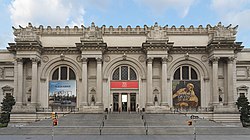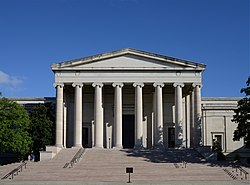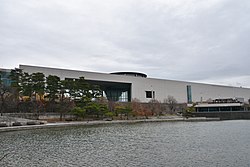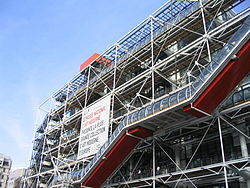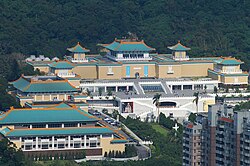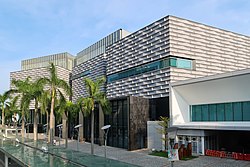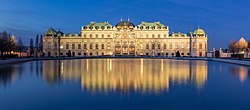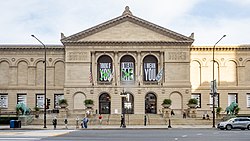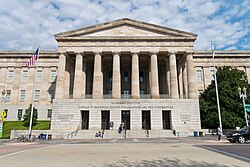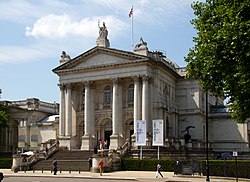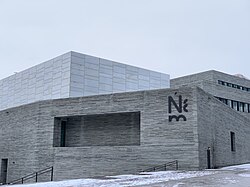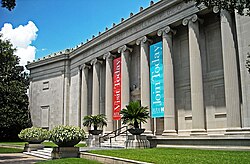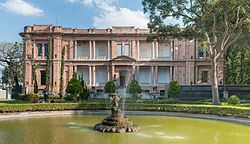Rank in 2024 [ 1] Museum Country and city Visitors annually Image (1) Louvre Paris 8,737,050 (2024) [ 2] [ 3] (2) Vatican Museums Vatican City , Rome 6,825,436 (2024) [ 3] (3) British Museum London 6,479,952 (2024) [ 3] (4) Metropolitan Museum of Art New York City 5,727,258 (2024) [ 3] (5) Tate Modern 4,603,025 (2024) [ 3] [ 4] (6) (new) Shanghai Museum East (opened 2024) Shanghai 4,234,046 (2024) [ 3] (7) National Gallery of Art Washington, D.C. 3,936,543 (2024) [ 3] (8) National Museum of Korea Seoul 3,788,785 (2024) [ 3] (9) Musée d'Orsay 3,751,141 (2024) [ 3] [ 5] (10) National Museum of Anthropology (Mexico) Mexico City 3,700,000 (2024) [ 6] (11) State Russian Museum Saint Petersburg 3,611,899 (2024) [ 3] (12) State Hermitage Museum 3,563,590 (2024) [ 3] (13) Victoria and Albert Museum 3,525,700 (2024) [ 7] (14) Museo del Prado Madrid 3,457,057 (2024) [ 8] (15) Pompidou Center 3,204,369 (2024) [ 3] (16) National Gallery 3,203,451 (2024) [ 3] [ 4] [ 9] (17) Wawel Castle Kraków 3,100,000 (2024) [ 10] (18) Somerset House 3,074,736 (2024) [ 11] (19) Uffizi Gallery Florence 2,908,828 (2024) [ 12] (20) Museum of Modern Art 2,657,377 (2024) [ 3] (21) M+ Hong Kong 2,612,691 (2024) [ 3] (22) Tretyakov Gallery 2,524,450 (2024) [ 3] (23) Rijksmuseum Amsterdam 2,500,000 (2024) [ 3] (25) Tokyo National Museum Tokyo 2,436,368 (2024) [ 3] (26) Art Gallery of New South Wales Sydney 2,369,339 (2024) [ 13] (27) (new) Shanghai Museum East (opened 2024) Shanghai 2,344,582 (2024) [ 14]
(28) National Museum of Scotland Edinburgh 2,314,974 (2024) [ 15] (29) NGV International (National Gallery of Victoria ) Melbourne 2,287,575 (2024), [ 16] (30) Museo Soumaya Mexico City 2,282,933 (2024) [ 17] (31) Royal Castle, Warsaw Warsaw 2,148,850 (2024) [ 18] (32) National Gallery Singapore Singapore 2,040,481 (2024) [ 19] (33) Acropolis Museum Athens 2,000,212 (2024) [ 20] (34) Scottish National Gallery Edinburgh 1,999,196 (2024) [ 21] (35) Tokyo Metropolitan Art Museum Tokyo 1,994,080 (2024) [ 22] (36) Kunsthistorisches Museum Vienna 1,954,269 (2024) [ 23] (37) National Palace Museum Taipei 1,874,994 (2024) [ 24] (38) National Museum in Kraków Kraków 1,859,484 (2024) [ 25] (39) Van Gogh Museum Amsterdam 1,840,000 [ 26] (40) National Art Center, Tokyo Tokyo 1,755,036 (2024) [ 27] (41) Hong Kong Museum of Art Hong Kong 1,763, 400 (2024) [ 28] (42) National Museum of Modern and Contemporary Art (Seoul branch) Seoul 1,655,834 (2024) [ 29] (43) National Museum of African-American History and Culture (Smithsonian Institution ) 1,600,000 (2024) [ 30] (44) National Portrait Gallery 1,578,0655 (2024) [ 31] (45) Pushkin Museum 1,551,628 (2024) [ 3] (46) Museo Reina Sofía Madrid 1,537,105 (2024) [ 32] (47) National Museum of Warsaw Warsaw 1,500,655 (2024) [ 33] [ 34] (48) Upper Belvedere Vienna 1,484,222 (2024) [ 35] (50) Petit Palais 1,459,371 (2024) [ 35] (51) National Folk Museum of Korea 1,443,298 (2024) [ 36] (53) Louvre Abu Dhabi Abu Dhabi 1,422,021 (2024) [ 35] (54) National Museum of Western Art, Tokyo Tokyo 1,367,385 (2024) [ 37] (55) Gyeongju National Museum Gyeongju 1,357,552 (2024) [ 38] (56) Doge's Palace Venice 1,333,314 (2024) [ 39] (57) Art Institute of Chicago Chicago 1,324,241 (2024) [ 40] (58) Guggenheim Museum Bilbao Bilbao 1,301,343 (2024) [ 41] (59) Getty Center 1,301,332 (2024) [ 42] (60) Museum of European and Mediterranean Civilisations (MUCEM) Marseille 1,300,000 (2024) [ 27] (61-62) Donald W. Reynolds Center National Portrait Gallery andSmithsonian American Art Museum ) 1,273,450 (2024) [ 43] (63) Musée du quai Branly 1,270,000 (2024) [ 44] (64) Centro Cultural Banco do Brasil Rio de Janeiro 1,234,872 (2024) [ 45] (65) Tate Britain 1,226,872 (2024) [ 46] (66) Moscow Kremlin Museums 1,214,851 (2024) [ 47] (67) Louis Vuitton Foundation 1,208,173 (2024) [ 48] (68) Musée de l'Orangerie 1,198,694 [ 49] (69) Kelvingrove Art Gallery and Museum Glasgow 1,182,204 (2024) [ 50] (70) Huntington Library, Art Museum and Botanical Gardens San Marino, California 1,152,416 (2024) [ 51] (71) Palazzo Reale, Milan Milan 1,150,282 (2024) [ 52] (72) Museum of New Zealand Te Papa Tongarewa Wellington 1,146,954 (2024) [ 53] (73) Museu Picasso Barcelona 1,128,140 (2024) [ 54] (74) Royal Ontario Museum Toronto 1,114,325 (2024) [ 55] (76) Albertina Vienna 1,069,500 (2024) [ 56] (77) National Gallery of Ireland Dublin 1,058,259 (2024) [ 57] (78) Tel Aviv Museum of Art Tel Aviv 1,057,362 (2024) [ 58] (79) Centro Cultural Banco do Brasil Rio de Janeiro 1,043,620 (2024) { [ 59] (80) Museo Egizio Turin 1,036,689 (2024) [ 60] (81) GES-2 (Moscow) Moscow 1,001,019 (2024) [ 61] (82) Istanbul Modern Istanbul 989,617 (2024) [ 62] (83) Museum of Fine Arts, Boston Boston 988,911 (2024) [ 63] (84) Thyssen-Bornemisza Museum 951,821 (2024) [ 64]
(85) CaixaForum Madrid 947,642 (2024) [ 65]
(86) National Museum of Art, Architecture and Design Oslo 946,000 (2024) [ 66] (87) Ashmolean Museum Oxford 942,692 (2024) [ 67] (88) Hong Kong Palace Museum Hong Kong 911,548 (2024) [ 35] (89) Palazzo Pitti Florence 909,020 (2024) [ 68] (90) Whitney Museum 888,816 (2024) [ 69] (91) Los Angeles County Museum of Art 873,825 (2024) [ 70] (92) Israel Museum Jerusalem 855,157 (2024) [ 71] (93) Museum of Fine Arts, Houston Houston 854,684 (2024) [ 72] (94) Museu Nacional d'Art de Catalunya (MNAC) Barcelona 854,496 (2024) [ 73] (95) Frederik Meijer Gardens & Sculpture Park Grand Rapids Charter Township, Michigan 851,626 (2024) [ 34] (96) The Broad 846,500 (2024) [ 74] (97) Palacio de Bellas Artes Mexico City 837,124 (2024) [ 75] (98) Museum of Contemporary Art Australia Sydney 833,699 (2024) [ 76] (99) Imperial War Museum 810,497 (2024) [ 77] (100) Pinacoteca do Estado de São Paulo São Paulo 810,444 (2024) [ 78] 



